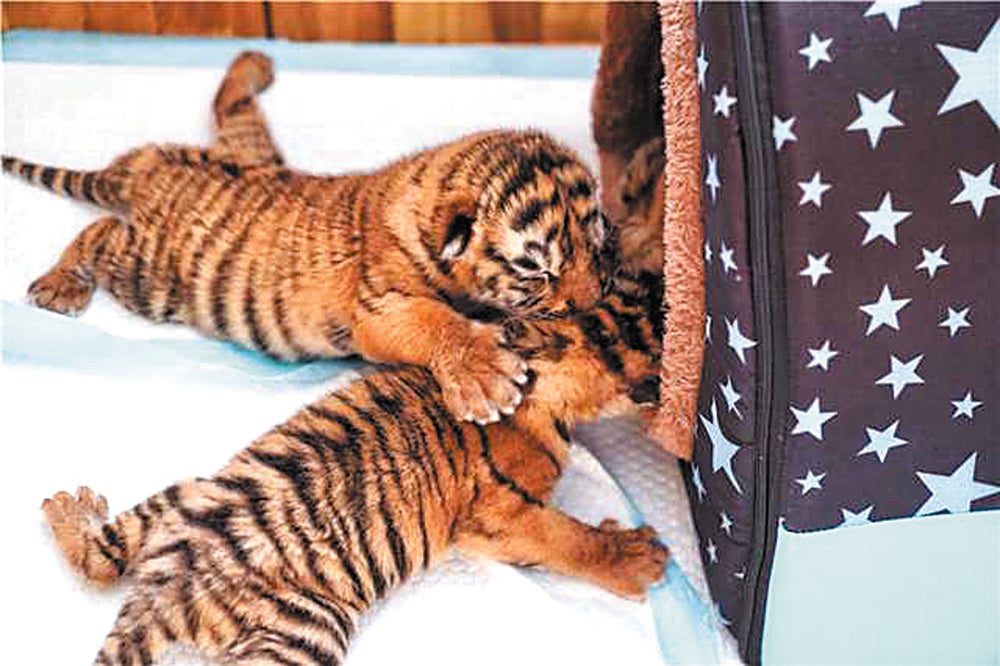Tiger cub births safeguard population growth
THE ARTICLES ON THESE PAGES ARE PRODUCED BY CHINA DAILY, WHICH TAKES SOLE RESPONSIBILITY FOR THE CONTENTS

Li Xin’s life has been extremely busy this summer after 24 cubs were born at the Siberian Tiger Park in Harbin, Heilongjiang province.
Since the 40-year-old became a breeding-programme expert at the park in 2004, his life has been closely tied to the big cats.
“I am responsible for feeding the tigers and monitoring their health, as well as cleaning out their living quarters,” he said. “These large animals look fierce, but sometimes they are also naughty and lovely. After a long time together, we are just like interdependent friends.”
The mating season for Siberian tigers usually falls in January and February. Every year during the birthing season, which runs from early April to late June, Li and three other breeding experts take turns to work 24-hour shifts to monitor the pregnant tigers, which are moved to separate living quarters in a special area about one month before they give birth.
“Every day, the breeders carefully disinfected both the indoor and outdoor living areas,” Li said. “The temperature in the living quarters stayed at 17C to 20C, which was comfortable for the animals.”
The experts paid great attention to the tiger mothers, checking their health by monitoring their appetites and daily activities during the 105-to-110-day pregnancy period.
In addition, they prepared an ample supply of nutritious food – including milk and eggs, as well as several kinds of vitamin pills – to help maintain the animals’ strength.
This year, eight tigers gave birth to cubs, including twins, triplets, quadruplets and quintuplets.
“Usually, Siberian tigers give birth to two to four cubs at a time, but it is rare to see healthy quintuplets,” Li said, noting that on May 10, a tiger gave birth to five cubs in one batch.
Most of the young mothers have no experience of nursing cubs, so the four experts took on the task of feeding the young tigers.
“The cubs’ body temperature dropped rapidly as their mothers did not take care of them after giving birth, so they had to be sent to the incubator and observed for 24 to 48 hours. After their body temperature returned to normal, they were taken to a designated room for artificial feeding,” Li said.
“They needed to be fed with milk every three hours for the first week after birth,” he added, explaining that the milk was made from a commercial tiger formula powder. “We also had to pay great attention to their health by monitoring their appetites, body temperatures and faeces.” Li said that when the cubs are older, they will be fed chopped meat.
Siberian tigers are a critically endangered species, with fewer than 500 believed to be roaming free in the wild. They mainly live in northeastern China and eastern Russia.
The Harbin park is one of three run by the China Hengdaohezi Feline Breeding Centre, the world’s largest such facility for these rare tigers. The others are located in Mudanjiang, Heilongjiang, and Shenyang, Liaoning province.
During more than 30 years of research, the centre has explored a complete set of scientific methods for the breeding and optimisation of Siberian tigers.
The centre now has more than 800 tigers, a huge rise from the initial group of 20 when it was founded in 1986, thus providing a guarantee for the full recovery of the animal’s population.
Subscribe to Independent Premium to bookmark this article
Want to bookmark your favourite articles and stories to read or reference later? Start your Independent Premium subscription today.